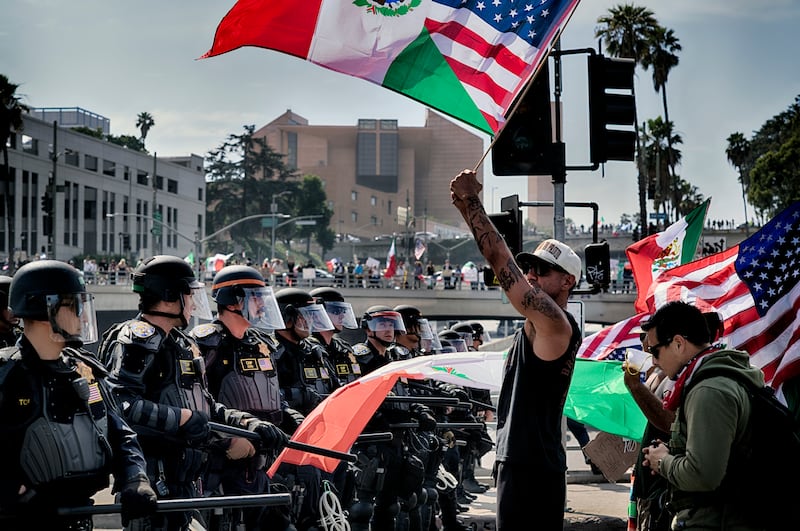- Sen. Mike Lee said President Trump is "well within his right" to use military troops to protect federal agents.
- Chicago residents have clashed violently with ICE officials multiple times over the past few weeks.
- Trump said on Monday that he can invoke the Insurrection Act to use federal forces domestically.
U.S. Attorney General Pam Bondi on Wednesday said President Donald Trump can legally invoke the Insurrection Act to deploy soldiers for law enforcement purposes as clashes between protesters and federal agents escalate across the country.
Her comments come ahead of what could be a contentious weekend, as millions of Americans are expected to participate in more than 2,500 “No Kings” protests scheduled to take place Saturday in all 50 states, including in Salt Lake City, Ogden and Provo.
The event is part of a series of demonstrations — at least partially funded by Democrat-leaning nonprofit groups — that have protested the Trump administration’s attempt to expand executive power over immigration, regulations and government spending.
“I pray that these protests remain entirely peaceful,” Utah Sen. Mike Lee told the Deseret News in a statement. “In the wake of leftist attacks on ICE and other members of law enforcement, however, President Trump is well within his rights to protect federal buildings and personnel.”
Clashes in Chicago continue
On Tuesday, Immigration and Customs Enforcement officers engaged protesters in Chicago with tear gas and rubber bullets when protesters began yelling and throwing objects at agents who had crashed into a car during an immigration enforcement traffic stop.
This was just the latest standoff between Chicago residents and ICE agents since the Trump administration launched a crackdown on illegal immigration in the nation’s third largest city five weeks ago. Other confrontations have seen protesters block and damage federal vehicles.
Over the past month, Trump has tried to call up National Guard troops from Oregon, California and Texas to protect federal agents and facilities in Chicago, and Portland — where there have been consistent anti-ICE protests since June.

Each of these efforts has been paused by district courts, who have stated that protesters in these cities likely do not meet the threshold of directly inhibiting the execution of laws or conducting a rebellion as outlined in the statute invoked by Trump in his June 7 executive order.
However, Trump, and his top legal advisers, have increasingly floated another avenue that would give the president much more freedom to deploy troops domestically with potentially less interference from the judicial system.
What is the Insurrection Act?
During a Wednesday appearance on Fox News’ “Hannity,” Bondi, the nation’s chief law enforcement officer, said the president can invoke the Insurrection Act as another means of using military might to ensure the administration’s initiatives are carried out.
“He absolutely has the right to do that, the legal authority to do that,” Bondi said.
Many legal experts agree. The Insurrection Act is a collection of statutes passed by Congress in the 18th and 19th centuries that gives the president wide latitude to mobilize the armed forces “as he considers necessary” to help enforce federal laws or suppress a rebellion.
The threshold for invoking the Insurrection Act is far lower than the one courts have scrutinized in reaction to Trump’s previous executive order, Mark Nevitt, a professor at Emory University’s School of Law and an expert in national security law, told The Dispatch.
The Insurrection Act would also allow Trump to avoid the complication of federalizing state National Guard units by instead deploying regular armed forces, wrote Jack Landman Goldsmith, a Harvard law professor and former assistant attorney general to President George W. Bush.
At least 10 U.S. presidents have used the Insurrection Act in over 20 separate instances. Most recently, the power was used by President George H.W. Bush at the request of then-Gov. Pete Wilson to restore civil order in Los Angeles after police officers were acquitted of beating Rodney King.

Trump would not be the first to use the Insurrection Act against the wishes of governors. The authority was invoked multiple times in the 1950s and ‘60s to enforce anti-segregation laws in the South and to protect civil rights marchers.
These cases involved governors’ flouting the constitutional rights of U.S. citizens. If Trump were to use the Insurrection Act to advance his policy objectives, it might more closely resemble 19th century invocations to quell labor strikes.
Will Trump invoke the Insurrection Act?
Over the past month, Trump administration officials have increasingly considered the possibility of using the Insurrection Act — something Trump toyed with, but never did, during his first term.
Earlier this month, Trump characterized Portland as a place filled with “insurrectionists,” while White House deputy chief of staff Stephen Miller referred to the unfriendly court decision in Oregon as a “legal insurrection.”

Vice President JD Vance said on Sunday the president was “looking at all of his options” to deploy military forces in domestic settings to control crime. And on Monday, Trump said if he wants to, he is “allowed to use the Insurrection Act.”
The Insurrection Act is the greatest exception to the Posse Comitatus Act, a law banning federal military forces from participating in law enforcement activities, according to Elizabeth Goitein, senior director at the Brennan Center’s Liberty and National Security Program.
While it was intended for emergencies when civilian law enforcement is overwhelmed, the Insurrection Act has very vague criteria and few clear constraints on its use, Goitein wrote. But despite criticism from across the political spectrum, Congress has failed to act to narrow the law.
“For years lawyers have been saying this is far too broad,” legal commentator Sarah Isgur said Sunday on ABC News. “They warned about it at the beginning of the Biden administration, ‘This is the time to change the Insurrection Act.’ We missed the opportunity then, and here we are.”


